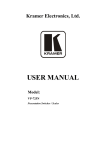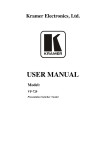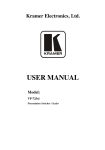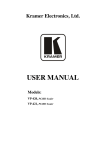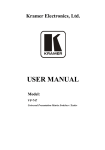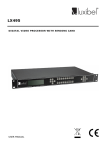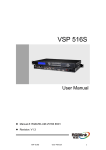Download USER MANUAL - Compagnie Events
Transcript
Kramer Electronics, Ltd. USER MANUAL Model: VP-728 Presentation Switcher / Scaler Contents Contents 1 2 2.1 3 3.1 3.2 4 5 6 6.1 7 7.1 7.2 Introduction Getting Started Quick Start Overview About HDMI Recommendations for Best Performance Your Presentation Switcher / Scaler Installing in a Rack Connecting your Presentation Switcher / Scaler Connecting a PC Presentation Switcher / Scaler Buttons Switching an Input The PIP Button Feature 1 1 1 3 5 6 6 10 11 13 14 14 14 7.3 7.4 8 8.1 8.2 8.3 8.4 8.5 8.6 8.7 Locking and Unlocking the Front Panel The Infrared Remote Control Transmitter Configuring the VP-728 via the OSD MENU Screens The Input Screen The Picture Screen The Output Screen The PIP Screen The Audio Screen The Geometry Screen The Setup Screen 18 18 20 21 22 23 24 25 26 27 8.8 9 10 10.1 10.2 10.3 11 12 12.1 Verifying Configuration Details via the Info Screen Using Text Overlay Audio Flash Memory Upgrade Downloading from the Internet Connecting the PC to the RS-232 Port Upgrading the Audio Firmware Technical Specifications VP-728 Communication Protocol Error Codes Description 32 33 35 35 35 36 41 46 56 7.2.1 7.2.2 7.2.3 7.2.4 8.7.1 8.7.2 Activating the PIP Feature Selecting the PIP Source Toggling between the PIP and the Screen Source (Swap) Quick Selection of the PIP Source via the Front Panel Buttons The Slideshow Feature The Advanced Setup Screen 15 15 16 16 28 28 i Contents Figures Figure 1: VP-728 Presentation Switcher / Scaler Front Panel Figure 2: VP-728 Presentation Switcher / Scaler Rear Panel Figure 3: Connecting the VP-728 Rear Panel Figure 4: Connecting the PC Figure 5: PIP Source Over Background Figure 6: OSD SWAP Status Figure 7: Infrared Remote Control Transmitter Figure 8: MENU Items Figure 9: Input Screen Figure 10: Picture Screen Figure 11: Output Screen Figure 12: PIP Screen Figure 13: Audio Screen Figure 14: Geometry Screen Figure 15: Setup Screen Figure 16: Advanced Setup Screen Figure 17: Misc Setup Screen Figure 18: Information Screen Figure 19: TextOverlay Application Screen Figure 20: RS-232 PINOUT Connection Figure 21: Splash Screen Figure 22: Atmel – Flip Window Figure 23: Device Selection Window Figure 24: Selecting the Device Window Figure 25: Loading the Hex Figure 26: RS-232 Window Figure 27: Atmel – Flip Window (Connected) Figure 28: Atmel – Flip Window (Operation Completed) 7 7 12 13 15 16 19 20 21 22 23 24 25 26 27 28 29 32 33 35 36 37 37 38 38 39 39 40 Tables Table 1: Front Panel Presentation Switcher / Scaler Features Table 2: Rear Panel Presentation Switcher / Scaler Features Table 3: PIP Source Appearance Availability Table 4: Infrared Remote Control Transmitter Functions Table 5: Input Screen Functions Table 6: Picture Screen Functions Table 7: Output Screen Functions Table 8: PIP Screen Functions Table 9: Audio Screen Functions Table 10: Geometry Screen Functions Table 11: Available Settings for Each Application Table 12: Setup Screen Functions Table 13: Mode Set Functions Table 14: OSD Functions Table 15: Misc Functions ii 8 9 17 19 21 22 23 24 25 26 26 27 29 29 30 KRAMER: SIMPLE CREATIVE TECHNOLOGY Contents Table 16: Input Functions Table 17: Output Functions Table 18: Features and Functions of the TextOverlay Application Table 19: RS-232 PINOUT Connection Table 20: Technical Specifications of the VP-728 Presentation Switchers / Scaler Table 21: Technical Specifications of the RGBHV / RGBS (PC) / RGsB (PC) Input Signal Table 22: Technical Specifications of the HDMI Input Signal (for RGB Colorspace) Table 23: Technical Specifications of the Y/C, Video Signal Table 24: Technical Specifications of the HDMI Signal (for RGB or YUV Colorspace) Table 25: Technical Specifications of the Component Input Signal Table 26: Technical Specifications of the RGBHV/Comp/YPbPr Output Signal Table 27: Technical Specifications of the HDMI/DVI/RGB Output Signal 31 31 34 36 41 42 42 43 43 43 44 45 iii Introduction 1 Introduction Welcome to Kramer Electronics! Since 1981, Kramer Electronics has been providing a world of unique, creative, and affordable solutions to the vast range of problems that confront the video, audio, presentation, and broadcasting professional on a daily basis. In recent years, we have redesigned and upgraded most of our line, making the best even better! Our 1,000-plus different models now appear in 11 groups1 that are clearly defined by function. Congratulations on purchasing your Kramer VP-728 Presentation Switcher / Scaler, which is ideal for the following typical applications: Projection systems in conference rooms, boardrooms, auditoriums, hotels and churches Production studios, rental and staging Any application where high quality conversion and switching of multiple and different video signals to graphical data signals is required for projection purposes The package includes the following items: VP-728 Presentation Switcher / Scaler Infrared remote control transmitter 2 sets of C-SF/2RVM cables, power cord2 and null-modem adapter This user manual3 2 Getting Started We recommend that you: Unpack the equipment carefully and save the original box and packaging materials for possible future shipment Review the contents of this user manual Use Kramer high performance high resolution cables4 2.1 Quick Start The quick start charts summarize the basic setup and operation steps of the VP-728. 1 GROUP 1: Distribution Amplifiers; GROUP 2: Switchers and Matrix Switchers; GROUP 3: Control Systems; GROUP 4: Format/Standards Converters; GROUP 5: Range Extenders and Repeaters; GROUP 6: Specialty AV Products; GROUP 7: Scan Converters and Scalers; GROUP 8: Cables and Connectors; GROUP 9: Room Connectivity; GROUP 10: Accessories and Rack Adapters; GROUP 11: Sierra Products 2 We recommend that you use only the power cord that is supplied with this machine 3 Download up-to-date Kramer user manuals from our Web site at http://www.kramerelectronics.com 4 The complete list of Kramer cables is on our Web site at http://www.kramerelectronics.com 1 Getting Started 2 KRAMER: SIMPLE CREATIVE TECHNOLOGY Overview 3 Overview The Kramer VP-728 is a 9-input Proscale™ Presentation Switcher / Scaler with unbalanced stereo and digital S/PDIF audio. The VP-728 scales any composite, s-Video (Y/C), component video (YUV), HDMI or computer graphics video signal, as well as jpeg files (via USB) up or down to a selectable graphics or HDTV output resolution and provides glitch-free switching between sources through FTB™ (fade-thru-black) switching technology. The output signal is available simultaneously on a 15-pin HD computer graphics video (UXGA) connector and on an HDMI connector. The VP-728 features include: Silicon Optix HQV® Video Processing - HQV (Hollywood Quality Video) processing represents the state-of-the-art in video processing technology, with the highest quality de-interlacing, noise reduction, and scaling performance for both standard-definition and high-definition signals Fade-Thru-Black (FTB™) Switching - the video fades to black and then the new input fades from black for glitch-free and smooth switching. The output signal provides constant sync so the display never glitches K-IIT XL™ Picture-in-Picture Image Insertion Technology - ultra stable picture-in-picture, picture-and-picture, and split screen capability. Any video source can be inserted into or positioned next to a computer graphics video source or vice versa with window positioning and sizing controls Four user definable (universal) video inputs (each can be set as composite video, s-Video (Y/C) or component video), two computer graphics video inputs, two HDMI inputs and 1 USB input (for reading JPEG picture files1) HDTV compatible component input HDTV output resolutions - 480p, 576p, 720p 1080i, and 1080p Scaled video outputs - HDMI and computer graphics video HDMI supports up to 2.25Gbps bandwidth per graphic channel2 Multiple computer graphics output resolutions - including a user-defined output resolution with selectable refresh rates Multiple aspect ratio selections Companion AFV (audio-follow-video) for every analog video input - supports embedded audio on the two HDMI inputs and output Built-in noise reduction and picture enhancement features 1 JPEG files in EXIF format are recognized up to 2048x1536 2 Suitable for resolutions up to UXGA at 60Hz, and for all HD resolutions 3 Overview Audio inputs - four (stereo audio or S/PDIF on two RCA connectors) for each of the four universal video inputs; two stereo audio (on 3.5mm connectors) for the two computer graphics video inputs; and embedded audio on the HDMI inputs Audio outputs - S/PDIF and stereo audio (RCA connectors). Transcodes stereo or S/PDIF audio to both stereo and S/PDIF audio and embeds audio onto the HDMI output Built-in Time Base Corrector - stabilizes video sources with unstable sync Built-in video Proc-Amp - color, hue, sharpness, contrast, and brightness are set individually for each input A BLANK button, a FREEZE button, a RESET TO XGA/720P button (to hardware-reset the output resolution); and a PANEL LOCK button1 Built-in audio Proc-Amp - with bass, treble, balance and loudness control, as well as audio delay Firmware upgrade support 2 via the USB port A slideshow feature, letting you run a slideshow via the USB port An OSD (On-Screen Display) – for making adjustments – that can be located anywhere on the screen3 In addition, the VP-728: Includes non-volatile memory that retains the last settings, after switching the power off and then on again Digitally reprocesses the signal to correct mastering errors, and regenerates the video at a higher line and pixel rate format, providing native-resolution video for LCD, DLP and plasma displays Is specifically designed to improve video quality by reducing chroma noise Scales and zooms (to up to 400% of the original size) Can provide non-linear scaling for 4:3, 16:9 transformation Control your VP-728 directly via the front panel push buttons, or: By RS-232 serial commands transmitted by a touch screen system, PC, or other serial controller Remotely, from the infrared remote control transmitter (with on-screen menus) The VP-728 is housed in a 19” 1U rack mountable enclosure, with rack “ears” included, and is fed from a 100-240 VAC universal switching power supply. 1 The front panel blank, freeze and lock buttons can be programmed via the OSD menu (see Table 15) 2 To check if firmware upgrades are available, go to our Web site at http://www.kramerelectronics.com 3 Centered on the screen, or in one of the four corners 4 KRAMER: SIMPLE CREATIVE TECHNOLOGY Overview 3.1 About HDMI High-Definition Multimedia Interface (HDMI) is an uncompressed all-digital1 audio/video interface, widely supported in the entertainment and home cinema industry. It delivers the maximum high-definition image and sound quality in use today. Note that Kramer Electronics Limited is an HDMI Adopter2 and an HDCP Licensee3. In particular, HDMI4: Provides a simple5 interface between any audio/video source, such as a set-top box, DVD player, or A/V receiver and video monitor, such as a digital flat LCD / plasma television (DTV), over a single lengthy6 cable Supports standard, enhanced, high-definition video, and multi-channel digital audio7 on a single cable Transmits all ATSC HDTV standards and supports 8-channel digital audio, with bandwidth to spare to accommodate future enhancements and requirements Benefits consumers by providing superior, uncompressed digital video quality via a single cable8, and user-friendly connector Is backward-compatible with DVI (Digital Visual Interface) Supports two-way communication between the video source (such as a DVD player) and the digital television, enabling new functionality such as automatic configuration and one-button play Has the capacity to support existing high-definition video formats (720p, 1080i, and 1080p/60), standard definition formats such as NTSC or PAL, as well as 480p and 576p 1 Ensuring an all-digital rendering of video without the losses associated with analog interfaces and their unnecessary digitalto-analog conversions 2 See http://www.hdmi.org/about/adopters_founders.asp 3 See http://www.digital-cp.com/list/ 4 HDMI, the HDMI logo and High-Definition Multimedia Interface are trademarks or registered trademarks of HDMI licensing LLC 5 With video and multi-channel audio combined into a single cable, the cost, complexity, and confusion of multiple cables currently used in A/V systems is reduced 6 HDMI technology has been designed to use standard copper cable construction at up to 15m 7 HDMI supports multiple audio formats, from standard stereo to multi-channel surround-sound. HDMI has the capacity to support Dolby 5.1 audio and high-resolution audio formats 8 HDMI provides the quality and functionality of a digital interface while also supporting uncompressed video formats in a simple, cost-effective manner 5 Your Presentation Switcher / Scaler 3.2 Recommendations for Best Performance To achieve the best performance: Connect only good quality connection cables, thus avoiding interference, deterioration in signal quality due to poor matching, and elevated noise-levels (often associated with low quality cables) Avoid interference from neighboring electrical appliances and position your Kramer VP-728 away from moisture, excessive sunlight and dust 4 Your Presentation Switcher / Scaler Figure 1, and Table 1 define the front panel of the VP-728; Figure 2 and Table 2 define the rear panel. 6 KRAMER: SIMPLE CREATIVE TECHNOLOGY Your Presentation Switcher / Scaler Figure 1: VP-728 Presentation Switcher / Scaler Front Panel Figure 2: VP-728 Presentation Switcher / Scaler Rear Panel 7 Your Presentation Switcher / Scaler Table 1: Front Panel Presentation Switcher / Scaler Features 4 5 6 Feature POWER Switch IR Receiver / LED UNIVERSAL INPUT Selector Buttons UXGA 1 UXGA 2 HDMI 1 7 8 HDMI 2 USB 9 10 11 12 13 14 15 16 17 18 19 20 INPUT Selector 2 Buttons # 1 2 3 Function Illuminated switch for turning the machine ON or OFF Red when the unit accepts IR remote commands Press to select the composite video / s-Video / component video 1 source (from 1 to 4) 1 Press to select the UXGA source 1 1 Press to select the UXGA source 2 Press to select the HDMI source 1 Press to select the HDMI source 2 3 Press to select the USB source and also run/stop the slideshow (see section 8.7.1) PIP Button Toggles the picture-in-picture function (see section 7.2) 4 BLANK Button Press to toggle between a blank screen (blue or black screen) and the display FREEZE Button Press to freeze/unfreeze the output video image4, as well as pause the slideshow (see section 8.7.1) MENU Button Displays the OSD menu screen (toggle) ENTER Button Moves to the next level in the OSD screen, or accepts a new parameter Decreases the range by one step in the OSD screen or moves to the Button previous level in the OSD screen Decreases the volume level, when not in the OSD menu Moves up one step (in the same level) in the OSD screen, or moves to Button the previous slide when running a slideshow (see section 8.7.1) Increases the range by one step in the OSD screen Button Increases the volume level, when not in the OSD menu Moves down one step (in the same level) in the OSD screen, or moves Button to the next slide when running a slideshow (see section 8.7.1) RESET TO XGA/720p Button Press and hold to reset to the default resolution5 PANEL LOCK Button Press to lock/unlock the front panel to prevent unintentional operation USB Connector Connect to a USB drive to read JPEG files, and also to download new firmware 1 And the appropriate audio source 2 When selected, button illuminates. See section 7.1 for details of how to program the INPUT SELECTOR buttons 3 JPEG files in EXIF format on a USB memory stick 4 Can be programmed to mute the audio signal at the same time (see Table 15) 5 Toggles between reset to XGA and reset to 720p 8 KRAMER: SIMPLE CREATIVE TECHNOLOGY Your Presentation Switcher / Scaler Table 2: Rear Panel Presentation Switcher / Scaler Features # 21 22 23 Feature Y/CV UNIV. IN RCA Connectors PB/C (from 1 to 4) PR Connect to the video acceptor which can be either composite video (Y/CV), s-Video (Y/CV, PB/C ) or component video (Y/CV, PB/C, PR) Function 24 UXGA 1 IN 15-pin HD Connector Connects to the UXGA (analog interface) graphics source 1 25 UXGA 2 IN 15-pin HD Connector Connects to the UXGA (analog interface) graphics source 2 26 AUDIO IN UNIV. IN RCA Connectors (from 1 to 4) R Connect to the left unbalanced stereo analog audio source; Alternatively, connect to a digital audio source Connect to the right unbalanced stereo analog audio source 28 29 AUDIO IN 3.5 Mini Jack UXGA 1 UXGA 2 Connects to the unbalanced stereo analog audio source 1 Connects to the unbalanced stereo analog audio source 2 30 31 32 AUDIO OUT RCA Connectors L R S/PDIF Connect to the left unbalanced stereo analog audio acceptor Connect to the right unbalanced stereo analog audio acceptor Connect to a digital audio acceptor 33 AUDIO PROG 27 L/S/PDIF Program Button 34 35 Push to upgrade to the latest Kramer audio firmware Release for normal operation Terminal Block Connector Connect to a PC for audio firmware upgrade HDMI 1 IN Connector Connect to the HDMI 1 source 36 HDMI 2 IN Connector 37 HDMI OUT Connector Connect to the HDMI acceptor 38 UXGA OUT 15-pin HD Connector Connects to the video acceptor that displays the scaled output In the default HDTV mode, the signal goes out via 3 PINS: PIN 1 is Pr, PIN 2 is Y, PIN 3 Pb 39 RS-232 9-pin D-sub Connector Connects to PC or Serial Controller 40 Power Connector with Fuse AC connector enabling power supply to the unit Connect to the HDMI 2 source 9 Installing in a Rack 5 Installing in a Rack This section describes what to do before installing in a rack and how to rack mount. Before Installing in a Rack Before installing in a rack, be sure that the environment is within the recommended range: Operating temperature range +5º to +45º C (41º to 113º F) Operating humidity range 10 to 90% RHL, non-condensing Storage temperature range -20º to +70º C (-4º to 158º F) Storage humidity range 5 to 95% RHL, non-condensing How to Rack Mount To rack-mount a machine: 1. Attach both ear brackets to the machine. To do so, remove the screws from each side of the machine (3 on each side), and replace those screws through the ear brackets. CAUTION!! When installing on a 19" rack, avoid hazards by taking care that: 1. It is located within the recommended environmental conditions, as the operating ambient temperature of a closed or multi unit rack assembly may exceed the room ambient temperature. 2. Once rack mounted, enough air will still flow around the machine. 3. The machine is placed straight in the correct horizontal position. 4. You do not overload the circuit(s). When connecting the machine to the supply circuit, overloading the circuits might have a detrimental effect on overcurrent protection and supply wiring. Refer to the appropriate nameplate ratings for information. For example, for fuse replacement, see the value printed on the product label. 5. The machine is earthed (grounded) in a reliable way and is connected only to an electricity socket with grounding. Pay particular attention to situations where electricity is supplied indirectly (when the power cord is not plugged directly into the socket in the wall), for example, when using an extension cable or a power strip, and that you use only the power cord that is supplied with the machine. 10 2. Place the ears of the machine against the rack rails, and insert the proper screws (not provided) through each of the four holes in the rack ears. Note that: In some models, the front panel may feature built-in rack ears Detachable rack ears can be removed for desktop use Always mount the machine in the rack before you attach any cables or connect the machine to the power If you are using a Kramer rack adapter kit (for a machine that is not 19"), see the Rack Adapters user manual for installation instructions (you can download it at: http://www.kramerelectronics.com) KRAMER: SIMPLE CREATIVE TECHNOLOGY Connecting your Presentation Switcher / Scaler 6 Connecting your Presentation Switcher / Scaler To connect1 the VP-728 as illustrated in the example in Figure 3, do the following2: 1. Connect the following video sources3: A component video4 source (for example, a DVD player) to the UNIV. IN 1 RCA connectors, Y/CV, PB/C and PR An s-Video source (for example, a DVD player) to the UNIV. IN 4 RCA connectors, Y/CV and PB/C A computer graphics source to the UXGA 1 IN 15-pin HD computer graphics video connector An HDMI source (for example, a DVD player) to the HDMI 1 IN connector A graphics data source (for example, JPEG files from a PC or a USB flash drive) to the USB connector on the front panel of the machine (not illustrated in Figure 3) 2. Connect the unbalanced stereo or digital audio sources5 (not illustrated in Figure 3): The audio of the component video source 1 to the AUDIO UNIV IN 1 S/PDIF RCA connector The audio of the s-Video source 4 to the AUDIO UNIV IN 4 L and R RCA connector The audio of computer graphics source to the AUDIO UXGA 1 3.5mm mini jack 3. Connect the video outputs: The HDMI OUT connector to an HDMI acceptor (for example, a plasma display) The UXGA OUT 15-pin HD computer graphics video connector6 to a video acceptor (for example, an analog display) 4. Connect the AUDIO OUT L and R unbalanced stereo audio output and/or the S/PDIF digital audio output to audio acceptors, for example, speakers (not illustrated in Figure 3). 1 Although this example shows only several inputs that are connected, you can connect all the inputs simultaneously 2 Switch OFF the power on each device before connecting it to your VP-729. After connecting your VP-729, switch on its power and then switch on the power on each device 3 You do not have to connect all the inputs 4 Sometimes called YUV, or Y, B-Y, R-Y, or Y, Pb, Pr 5 As required. Not all devices need to be connected 6 In the HDTV mode, the signal goes out via three PINS: PIN 1 is Red or Pr, PIN 2 is Green or Y, PIN 3 is Blue or Pb 11 Connecting your Presentation Switcher / Scaler 5. Connect the power cord1 (the power connector is not illustrated in Figure 3). 6. If required, connect A PC via RS-232, see section 6.1 Figure 3: Connecting the VP-728 Rear Panel 1 We recommend that you use only the power cord that is supplied with this machine 12 KRAMER: SIMPLE CREATIVE TECHNOLOGY Connecting your Presentation Switcher / Scaler 6.1 Connecting a PC You can connect a PC (or other controller) to the VP-728 via the RS-232 port for remote control. To connect a PC to a VP-728 unit, using the Null-modem adapter provided with the machine (recommended): Connect the RS-232 9-pin D-sub rear panel port on the VP-728 unit to the Null-modem adapter and connect the Null-modem adapter with a 9-wire flat cable to the RS-232 9-pin D-sub port on your PC To connect a PC to a VP-728 unit, without using a Null-modem adapter: Connect the RS-232 9-pin D-sub port on your PC to the RS-232 9-pin D-sub rear panel port on the VP-728 unit, forming a cross-connection1, as Figure 4 illustrates PIN 5 Connected to PIN 5 (Ground) PIN 3 Connected to PIN 2 PIN 2 Connected to PIN 3 9-pin D-sub (From PC) 9-pin D-sub (To Presentation Switcher/Scaler) If a shielded cable is used, connect the shield to PIN 5 Figure 4: Connecting the PC 1 Also known as a Null-modem connection 13 Presentation Switcher / Scaler Buttons 7 Presentation Switcher / Scaler Buttons The VP-728 includes the following front panel buttons: Nine INPUT selector buttons, see section 7.1 A PIP button, see section 7.2 BLANK and FREEZE buttons Six OSD buttons A RESET TO XGA/720p button A PANEL LOCK button, see section 7.3 7.1 Switching an Input Each INPUT SELECTOR button can be used to select the source. You can switch seamlessly1 between each input that is connected to a source, by pressing the appropriate INPUT SELECTOR button. 7.2 The PIP Button Feature The Picture-in-Picture inserter (PIP) uses K-IIT XL™ image insertion technology to present video and graphic sources simultaneously2. You can display: An inserted video source3 PIP over a graphic source4 An inserted graphic source4 PIP over a video source3 Three types of PIP insertions are available: Picture-in-Picture – the PIP image appears over the background image Picture + Picture – both the video source and the graphic source are placed side by side and have the same height (the PIP image is stretched lengthwise) Split – both the video source and the graphic source are placed side by side (the PIP image appears smaller than the defined size and the source size is reduced) 1 FTB™ switching for glitchless transitions between inputs 2 If the HDMI signal is HDCP protected, it cannot appear on a display that is not HDCP compliant, and the machine will not output a picture on the VGA output 3 That is, composite, s-Video 4 That is, HDMI or UXGA or component 14 KRAMER: SIMPLE CREATIVE TECHNOLOGY Presentation Switcher / Scaler Buttons 7.2.1 Activating the PIP Feature You can activate the PIP by: Pressing the PIP button Pressing the PIP key on the infrared remote control transmitter (see section 7.4, Figure 7) Switching on the PIP functionality via the OSD Menu (see Figure 12 and Table 8) 7.2.2 Selecting the PIP Source To use the PIP feature, set the PIP source via the OSD menu (see Figure 12 and Table 8) or the remote-transmitter keys. To set the PIP source via the OSD menu, do the following: 1. Press the MENU button to enter the OSD menu. 2. Press the button to move to the PIP icon. 3. Scroll down to select Source and press ENTER. 4. Use the or buttons to select the PIP Source from the drop-down list box, and press ENTER (see Figure 12). 5. To exit the OSD menu, press the MENU button. Figure 5: PIP Source Over Background 15 Presentation Switcher / Scaler Buttons 7.2.3 Toggling between the PIP and the Screen Source (Swap) To toggle back and forth between the PIP source and the main display, as Figure 6 illustrates, press the Swap key on the infrared remote control transmitter (see Figure 7). Figure 6: OSD SWAP Status 7.2.4 Quick Selection of the PIP Source via the Front Panel Buttons For quick selection of the PIP source, press and hold the PIP front panel button while pressing the input button of the required PIP source. For example, to select UXGA 2 as the graphic PIP source over a video background, press the PIP front panel button while pressing the UXGA 2 front panel button. When attempting to select a PIP source of the same category as the background source (for example, video on video, which is not compliant to Table 3), a message is prompted: “unavailable operation” To replace a PIP in the same category (for example, changing the PIP source from UXGA 1 to HDMI 2), press the required PIP Source on the remote control transmitter and the PIP display will change accordingly. You can swap the PIP source category with the main source category via the: Remote control keys, by selecting a new main source and then a new PIP source OSD menu, by selecting a new Input source through the Input menu and a new PIP source through the PIP menu When selecting one PIP source, the Presentation Switcher / Scaler automatically recognizes and displays the selected graphic PIP source on all the video displays1 and the selected video source on all the graphic1 displays, compliant to Table 3. 1 Even if the input signal is not connected. In this case the PIP appears over a blank screen 16 KRAMER: SIMPLE CREATIVE TECHNOLOGY Presentation Switcher / Scaler Buttons Table 3: PIP Source Appearance Availability PIP Source Main Source Input 1 Video Input 2 YC Comp. Video YC Comp. VGA 1 VGA 2 VGA 3 VGA 4 No No No No No YC No No No No No Yes Yes Yes Yes Yes Comp. No No No Yes Yes No No No No No Video No No Yes No No No Yes Yes Yes Yes YC No No Yes No No No Yes Yes Yes Comp. Yes Yes No No No No No No VGA 1 Yes Yes No Yes Yes No No VGA 2 Yes Yes No Yes Yes No VGA 3 Yes Yes No Yes Yes VGA 4 Yes Yes No Yes HDMI 1 Yes Yes No Yes HDMI 2 Yes Yes No USB1 Yes Yes No Input 2 Input 1 Video Yes Yes Yes Yes Yes HDMI 1 Yes HDMI 2 USB Yes No Yes Yes No No No No Yes Yes No Yes Yes Yes No No No No No No No No No No No No No No No No No No No No No No No No No No No Yes No No No No No No No No Yes No No No No No No No No Yes Yes No No No No No No No No Yes Yes No No No No No No No No 1 For a USB source with the PIP enabled, the output image size is limited to 960 horizontal pixels 17 Presentation Switcher / Scaler Buttons 7.3 Locking and Unlocking the Front Panel To prevent changing the settings accidentally or tampering with the unit via the front panel buttons, lock your VP-728. Unlocking releases the protection mechanism. When the front panel is locked, control is still available via RS-232. To lock the VP-728: Press the PANEL LOCK button on the front panel. The front panel is locked and the PANEL LOCK button is illuminated. Pressing a button will have no effect To unlock the VP-728: Press the illuminated PANEL LOCK button on the front panel The front panel unlocks and the PANEL LOCK button is no longer illuminated For a description of the Save Lock and Input Lock OSD functions, see Table 15. 7.4 The Infrared Remote Control Transmitter You can control the VP-728 remotely, from the infrared remote control transmitter, which: Is a hand held instrument with a convenient keypad that receives its power from 2 AAA size 1.5V DC batteries Has a range of up to 15 meters Delivers instantaneous results 18 KRAMER: SIMPLE CREATIVE TECHNOLOGY Presentation Switcher / Scaler Buttons Figure 7 and Table 4 define the infrared Remote Control Transmitter: Table 4: Infrared Remote Control Transmitter Functions key Freeze Function 1 Pauses the output video Blank Toggles between a blank screen (blue or black screen) and the display Cycles power POWER Main Source 9 separate keys for selecting each of the following sources: Input 1, Input 2, Input 3, Input 4, VGA 1, VGA2, HDMI 1, HDMI 2 and USB Reset Press and hold to reset to the default resolution Info Press to toggle the Info OSD menu Capture Capture an image to place as a logo or background (see Table 15) Shows the main OSD Menu MENU 2 Navigation arrows Allows maneuvering within an OSD screen (left, right, up and down, as well as the ENTER arrow at the center) The + and - buttons increase and decrease the volume level, respectively (when not in the OSD menu) Auto Image Assesses the image and improves the quality accordingly, by automatically adjusting the phase, frequency and position Save Saves a profile Recall Recalls a profile Picture Shows the Picture OSD menu PIP source Nine separate keys for selecting each of the following PIP sources: Input 1, Input 2, Input 3, Input 4, VGA 1, VGA2, HDMI 1 and HDMI 2 Mutes the audio signal Mute Swap Toggles between the PIP content and the parent screen content PIP Selects the picture-in-picture function and illuminates the PIP button3 Figure 7: Infrared Remote Control Transmitter 1 Can be programmed to mute the audio signal at the same time (see Table 15) 2 Toggles between reset to XGA and reset to 720p 3 See section 7.2 19 Configuring the VP-728 via the OSD MENU Screens 8 Configuring the VP-728 via the OSD MENU Screens The OSD superimposes a menu on the screen from which you can configure and control each input signal on your VP-728, using the MENU, ENTER, , , and OSD buttons on the front panel and the remote transmitter. To use the OSD menus: 1. Select the desired input signal. 2. Use the menu buttons as follows: Press the MENU front panel OSD button or the MENU key on the infrared remote control transmitter (see Figure 7) to display the main MENU screen1, which displays eight interactive icons (see Figure 8) Press the MENU front panel OSD button or the MENU key on the infrared remote control transmitter to move to the previous level in the OSD screen (Esc) Press the UP or DOWN buttons to select menu icons and then press ENTER Use + and – buttons to increase and decrease the (numerical) rate respectively Figure 8: MENU Items 1 Each icon represents a Level 1 function. In addition to Level 1, the OSD structure includes Level 2 (a subset of level 1), Level 3 (a subset of level 2), Level 4 (a subset of level 3) and a numerical range 20 KRAMER: SIMPLE CREATIVE TECHNOLOGY Configuring the VP-728 via the OSD MENU Screens 8.1 The Input Screen Figure 9 and Table 5 define the Input screen. Figure 9: Input Screen Table 5: Input Screen Functions1 Setting Source2 Function Select the source3 Input (1 to 4) Source Type Select the source type Image Name Selection Input 1, Input 2, Input 3, Input 4, VGA 1, VGA 2, HDMI 1, HDMI 2 or USB Default Component, YC or video (CV) Video 4 Shows the file name that is displayed when the USB port is connected Color Format Select the color format Auto, RGB or YUV Auto Video Standard Select the video standard Auto, NTSC, PAL, PAL-M, PAL-N, NTSC 4.43, SECAM or PAL-60 Auto 5 H-Position Set the horizontal position Set according to the input resolution V-Position Set the vertical position Set according to the input resolution Frequency Adjust the frequency6 0 to 50 0 Phase Adjust the phase 0 to 31 0 Auto image Assesses the image and improves the quality accordingly, by automatically adjusting the phase, frequency and position 1 Values may change according to the firmware version (you can download the up-to-date firmware version from our Web site at http://www.kramerelectronics.com) 2 When switching sources, the image fades through black 3 Automatically updated when pressing an input front panel button on the machine 4 Supports JPEG format only. The JPEG file should not exceed a resolution of 2048x1536. If the image file is not within the definition, the machine displays the message: “Size Too Big” 5 For UXGA and component video inputs 6 For UXGA inputs 21 Configuring the VP-728 via the OSD MENU Screens 8.2 The Picture Screen The Brightness, Contrast, Color and Hue picture settings are saved individually for each input (except USB). Figure 10 and Table 6 define the Picture screen. Figure 10: Picture Screen Table 6: Picture Screen Functions1 Brightness Setting Function Adjust the brightness Contrast Adjust the contrast 0 to 100 Color Adjust the color 0 to 100 55 Hue Adjust the hue 0 to 360 180 Sharpness Output Gamma Adjust the sharpness Adjust the gamma 0 to 100 Gamma 1 to Gamma 5 50 Gamma 1 Film Mode Set the film mode Auto, Video, Film Auto Temporal NR Set the temporal noise reduction level Set the Mosquito noise reduction level Off, Low, Medium, High High Off, Low, Medium, High Low Off, On Off Off, Low, Medium, High Medium2 Off, Low, High Low Off, Low, High Low Mosquito NR Block NR Set the block noise reduction level Detail Enhancement Set the detail enhancement Luma Transition Enhance Set the luminance transition enhance level Chroma Transition Enhance Set the chrominance transition enhance level Selection/Range 0 to 100 Default 50 50 1 Values may change according to the firmware version (you can download the up-to-date firmware version from our Web site at http://www.kramerelectronics.com) 2 If the USB input is selected, Detail Enhancement is set to Off 22 KRAMER: SIMPLE CREATIVE TECHNOLOGY Configuring the VP-728 via the OSD MENU Screens 8.3 The Output Screen Figure 11 and Table 7 define the Output screen. Figure 11: Output Screen Table 7: Output Screen Functions1 Setting 2 Resolution Function 3 Set the resolution Selection/Range Default 1024x768@60Hz Native HDMI, 640x480x60Hz, 640x480x75Hz, 800x600x50Hz, 800x600x60Hz, 800x600x75Hz, 1024x768x50Hz, 1024x768x60Hz, 1024x768x75Hz, 1280x768x50Hz, 1280x768x60Hz, 1280x720x60Hz, 1280x800x60Hz, 1280x1024x50Hz, 1280x1024x60Hz, 1280x1024x75Hz, 1366x768x50Hz, 1366x768x60Hz, 1400x1050x50Hz, 1400x1050x60Hz, 1600x1200x50Hz, 1600x1200x60Hz, 1680x1050x60Hz, 1920x1080x60Hz, 1920x1200x60Hz, 480px60Hz, 576px60Hz, 720px50Hz, 720px60Hz, 1080ix50Hz, 4 1080ix60Hz, 1080px50Hz, 1080px60Hz, or Custom HDMI Type Set the HDMI type Auto, HDMI, DVI Aspect Ratio Set the aspect ratio Best Fit5, Letterbox, Follow Output6, 7 Virtual Wide, Follow Input , or Custom Best Fit H-Pan8 Horizontal pan -16 to 16 0 V-Pan8 Vertical pan -16 to 16 0 H-Zoom8 Horizontal zoom -8 to 8 0 auto V-Zoom8 Vertical zoom -8 to 8 0 Zoom Set the Zoom 100%, 150%, 200%, 225%, 250%, 275%, 300%, 325%, 350%, 375%, 400%, Custom 100% Custom Zoom Set the Zoom From 100% to 400% Zoom H-Pan 0 to 31 16 Zoom V-Pan 0 to 31 16 1 Values may change according to the firmware version (you can download the up-to-date firmware version from our Web site at http://www.kramerelectronics.com) 2 For the most updated resolution list, go to our Web site at http://www.kramerelectronics.com 3 Any change in the resolution must be confirmed via the count-down message that appears on the screen 4 From Custom 1 to Custom 4 5 The best possible compromise between the input and the output aspect ratios 6 If the input output, scale up the picture. If the input 7 If the input output, display with a blank border. If the input output, scale down the picture output, crop the image 8 Available when selecting Custom aspect ratio 23 Configuring the VP-728 via the OSD MENU Screens 8.4 The PIP Screen Figure 12 and Table 8 define the PIP screen. Figure 12: PIP Screen Table 8: PIP Screen Functions1 Setting On/Off Type Function Activate/deactivate the PIP 2 feature Select the PIP type Selection/Range Default Off On/Off Source Select the PIP source Picture-In-Picture, Picture + Picture3 or Split See Table 3 PIP Size Select the PIP size5 1/25, 1/16, 1/9, 1/4, or Custom 1/4 H-Position Set the horizontal position of the PIP on the display 0 – 128 3 V-Position Set the vertical position of the PIP on the display 0 – 128 0 H-Size Set custom size6 1 – 256 V-Size Set custom size6 1 – 256 Frame Turn the PIP frame on or off On/Off On Frame Color Select the color of the PIP frame Red, Green or Blue Blue 4 Picture-InPicture 1 Values may change according to the firmware version (you can download the up-to-date firmware version from our Web site at http://www.kramerelectronics.com) 2 For a USB source with the PIP enabled, the maximum output image size is 960 horizontal pixels 3 Maintains the aspect ratio 4 When changing the PIP source, the display fades through black 5 The PIP size can be set up to the full height and up to half the width of the screen 6 The actual range depends upon the input resolution 24 KRAMER: SIMPLE CREATIVE TECHNOLOGY Configuring the VP-728 via the OSD MENU Screens 8.5 The Audio Screen Figure 13 and Table 9 define the Audio screen. Figure 13: Audio Screen Table 9: Audio Screen Functions1 Setting Type Function Select the audio input type2 Selection/Range Analog or S/PDIF Default Analog Input Volume Adjust the input volume -22 to 22 0 Output Volume Adjust the output volume -100 to 24 0 Bass Adjust the bass -36 to 36 0 Treble Adjust the treble -36 to 36 0 Balance Adjust the balance -10 to 10 0 Loudness Set the loudness On/Off Off Delay Define the delay type Dynamic or User Define Dynamic3 User Delay Available when selecting the User Defined delay 0 to 3404 (msec) 0 USB Select the audio signal to follow the USB signal No Audio, Input 1, Input 2, Input 3, Input 4, VGA 1, VGA 2, HDMI 1 or HDMI 2 No Audio 1 Values may change according to the firmware version (you can download the up-to-date firmware version from our Web site at http://www.kramerelectronics.com) 2 Available for IN 1 to IN 4 3 Dynamic means that the audio delay is equal to the pipeline video delay 4 In 2msec steps 25 Configuring the VP-728 via the OSD MENU Screens 8.6 The Geometry Screen Figure 14 and Table 10 define the Geometry screen, allowing the user flexibility in positioning his projector relative to the screening surface. Figure 14: Geometry Screen Table 10: Geometry Screen Functions1 Setting Application Location Default Keystone Front Horizontal Keystone Function Selection/Range Select the output application Keystone, Anyplace or Rotation Select the location of the Front, Rear, Ceiling or Rear ceiling display 2 Adjust the horizontal keystone -40 to 40 Vertical Keystone Adjust the vertical keystone3 0 Diagonal Projection Move the location of each Top Left, Top Right, Bottom Left, corner of the display Bottom Right or Reset (to reset separately diagonal projections settings) Adjust the pincushion or barrel -20 to 20 appearance of the screen Rotate the display by 180 -180 to 180 degrees clockwise or counterclockwise Resets the geometry values to their default value Pincushion/Barrel Rotation Reset all -30 to 30 0 Top Left 0 0 Table 11 defines the settings available for each application: Table 11: Available Settings for Each Application Application Available Settings Keystone Location, horizontal keystone, vertical keystone, pincushion/barrel and Reset all Anyplace Rotation Location, Diagonal Projection and Reset all Location, pincushion/barrel, Rotation and Reset all 1 Values may change according to the firmware version (you can download the up-to-date firmware version from our Web site at http://www.kramerelectronics.com) 2 If the projector is located at an angle to the left or right of the screen 3 If the projector is located at an angle above or below the screen 26 KRAMER: SIMPLE CREATIVE TECHNOLOGY Configuring the VP-728 via the OSD MENU Screens 8.7 The Setup Screen Figure 15 and Table 10 define the Setup screen. Figure 15: Setup Screen Table 12: Setup Screen Functions Setting Save Function Save a profile Selection/Range From Profile 1 to Profile 8 Default Recall Recall a profile From Profile 1 to Profile 8 Slideshow Set speed for slide show (see section 8.7.1) Min, Low, Mid, Long, Max, Off Off Frame Lock Locks the vertical refresh rate of the output to that of the input1,2 On/Off Off Auto Image Automatically adjust and align the picture each time of the UXGA inputs is selected or if the UXGA input resolution has changed Manual, Auto Manual Seamless, Fast Seamless Switching Mode Select seamless switching (fade-throughBlack) or Fast switching which is faster but may cause glitches on the output (applies when switching between analog inputs) Reset your VP-728 to its preset default Factory Reset settings Advanced Setup: Open the advanced setups (see Figure 16) Yes/No Mode Set (see Table 13) OSD (see Table 14) Misc (see Table 15) Input (see Table 16) Output (see Table 17) 1 Note that seamless switching is not possible when working in the Frame Lock mode unless all sources are frame synchronized 2 In cases where the output resolution can support the vertical refresh rate of the input, the output refresh rate will change according to the input refresh rate 27 Configuring the VP-728 via the OSD MENU Screens 8.7.1 The Slideshow Feature The VP-728 lets you run a slideshow via the USB input and set the slideshow speed via the slideshow feature. To prepare a slideshow: 1. Load the slideshow JPEG1 images to a USB memory stick. The slides will appear in alphabetical order. 2. Open the Setup menu and set the desired speed in the slideshow item and then close the menu. 3. Connect the Memory stick to the USB connector on the front panel. 4. Select the USB INPUT button on the front panel. The slideshow begins at the set speed. You have to set the slideshow parameters before you run the slideshow You can control the slide show by pressing the: FREEZE button to pause USB button to play and stop the slideshow (up arrow) button to go to the previous slide (down arrow) button to go to the next slide 8.7.2 The Advanced Setup Screen Figure 16 and Table 14 to Table 17 (inclusive) define the Advanced Setup screen. Figure 16: Advanced Setup Screen 1 JPEG files are recognized up to 2048x1536 28 KRAMER: SIMPLE CREATIVE TECHNOLOGY Configuring the VP-728 via the OSD MENU Screens The Mode Set functions define the desired working resolution and refresh rate when the system cannot distinguish between similar resolutions and refresh rate values (see Table 13). Table 13: Mode Set Functions Setting Mode 11 Function Set mode 1 Selection/Range 1400x1050x60Hz 1680x1050x60Hz Default 1400x1050x60Hz Mode 21 Set mode 2 1280x1024x75Hz 1280x1024x76Hz 1280x1024x75Hz Table 14: OSD Functions Setting Menu Position Function Set the location of the OSD menu Selection/Range Default Center, Top Left, Top Right, Center Bottom Left, Bottom Right Time Out (sec) Set the OSD menu timeout 5, 10, 20, 30, 60, 90 or Off 30 Figure 17 and Table 15 define the Misc Setup screen. Figure 17: Misc Setup Screen 1 Since both resolutions have the same number of lines, we can define for the unit to identify the above resolutions as 1400x1050 or as 1680x1050 29 Configuring the VP-728 via the OSD MENU Screens Table 15: Misc Functions Setting Logo Function Choose ON for the start up logo to appear on the screen OFF for it not to appear Set to Custom to download a custom Logo1 (Flash ROM) Selection/Range On, Off or Custom Default Kramer Logo Blank Color Set the blank color (the color that appears on the screen when the blank button is pressed) Black or Blue Blue Capture Press to capture the currently displayed image. This captured image can be used as a logo, or as the background if the Background setting is set to Custom, or when no input is connected and the output sync is ON. Note: 1. The unit can capture the image for an input source with a resolution up to 1920x1200 2. The output resolution must be <1400 horizontal pixels in order to capture 3. The PIP must be off in order to use the capture feature Prompts “Capture” If PIP is on, prompts "Cannot Capture with PIP If the output resolution is too high, prompts "Output resolution too high for Capture" Background Set the background screen color if an input without a signal is selected Blue, Black, Custom or 2 Disable Analog Sync Default Save Lock Set the Save Lock option to ON to save the lock status when the machine is powered down On/Off Off Input Lock Set the Input Lock to OFF so you can still use the SOURCE buttons on the front panel even when the lock button is on On/Off On Firmware Download Download the firmware via the USB connection Confirmation Logo Download Download a new logo via the USB connection Blank Define the function of the BLANK front panel button Blank & Mute, Blank, Mute Blank & Mute Freeze Define the function of the FREEZE front panel button Freeze & Mute, Freeze, Mute Freeze & Mute HDCP Setting Define whether the HDCP will follow the input or the output Follow Input3, Follow Output4 Monitor Overscan Allows stretching of the outputted On, Off 1 Off 1 Obtained via the Capture function or downloaded via USB 2 When selected, if an input is not connected for over 2 minutes, will cause the output SYNC to turn Off 3 When Follow Input is selected, the Scaler changes its HDCP output setting (for the HDMI output) according to the HDCP of the input. This option is recommended when the HDMI Scaler output is connected to a splitter/switcher (in this mode, switching may not be glitch-free) 4 When Follow Output is selected, the Scaler matches its HDCP output to the HDCP setting of the HDMI acceptor to which it is connected. This ensures smooth switching, regardless of the input 30 KRAMER: SIMPLE CREATIVE TECHNOLOGY Configuring the VP-728 via the OSD MENU Screens Table 16: Input Functions Setting Custom Input Function Custom Input HT Horizontal Total 1344 HW Horizontal sync pulse width 136 HS Horizontal active start point 296 HA Horizontal active region 1024 HP Horizontal polarity VT Vertical Total VW Vertical sync pulse width 6 VS Vertical active start point 35 VA Vertical active region 768 VP Vertical polarity OCLK Output clock 65 Enable Set to On to enable parameter change Apply settings N/A Save Range Custom 1 to custom 4 Default Custom 1 806 Off Table 17: Output Functions Setting Custom Output Function Custom 1 to Custom 4 HT Horizontal total 1344 HW Horizontal sync pulse width 136 HS Horizontal active start point 296 HA HP Horizontal active region Horizontal polarity 1024 VT Vertical total 806 VW Vertical sync pulse width 6 VS Vertical active start point 35 VA Vertical active region 768 VP Vertical polarity OCLK Output clock Apply Press to apply the settings Save Save setup Set Current Import the values of the currently selected output resolution into the User Mode Setting Range Custom 1 Default 65 N/A 31 Configuring the VP-728 via the OSD MENU Screens 8.8 Verifying Configuration Details via the Info Screen From the Information screen (see Figure 18), you can verify the main source, PIP source, the output resolution, the SYNC mode, as well as the firmware revision and the audio board firmware version (for example, 2.2 in Figure 18): Figure 18: Information Screen 32 KRAMER: SIMPLE CREATIVE TECHNOLOGY Using Text Overlay 9 Using Text Overlay The text overlay feature is accessed via the Application Program (AP)1. Running this AP with the PC connected to the VP-728 lets you display text over the screen, with features including text color and speed, transparency, text position and repetition. Current text overlay settings can be saved and loaded to the AP. Figure 19 and Table 18 define the Text Overlay Application Screen: Figure 19: TextOverlay Application Screen 1 You can download the latest software from our Web site: http://www.kramerelectronics.com 33 Using Text Overlay Table 18: Features and Functions of the TextOverlay Application Feature Function Parameter Setting Area Text Color Dropdown Box Select the Text color Background Color Dropdown Box Transparency Dropdown Box Set the text background color Display Height Check Box Text Position – V-Position Select On for a transparent background or Off for a non-transparent background Set the thickness of the background stripe (72 or 36) Set the vertical position of the text background on the display screen (Top, Center or Bottom) Communication Interface Area Connect/Disconnect TCP/IP Check box Connect the machine or disconnect Not available RS-232 Check box When selected, set the COM port and Baud Rate (9600) to connect via the RS-232 connector Scrolling Mode Area Blank Time (Sec) Dropdown Box Speed Dropdown Box Mode Send Text Area Message Repeat Dropdown Box H-Offset Dropdown Box Start Button Stop Button Quit Button Load Setting Button Save Setting Button Set the blank delay time (from 1 to 5) Set the speed at which the text moves on the display (from 1 to 5) Set to Still (fixed text) or Scrolling (text moves across the display) Type the desired text in the Message box Set the number of times that the text message will scroll across the screen1 (1 to 20), or set to Forever to repeat the text message continuously After selecting the Static mode, use the H-Offset box to select the horizontal position of the text (Left Center or Right) Click to display the text on screen Click to stop scrolling on screen Click to quit the program Click to load a previously saved setting Click to save the current setting 1 For example, set to 2 to repeat the text twice 34 KRAMER: SIMPLE CREATIVE TECHNOLOGY Audio Flash Memory Upgrade 10 Audio Flash Memory Upgrade The VP-728 audio firmware is located in FLASH memory, which lets you upgrade1 to the latest Kramer firmware version in minutes! The process involves: Downloading from the Internet (see section 10.1) Connecting the PC to the AUDIO PROG. terminal block connector (see section 10.2) Upgrading Firmware (see section 10.3) 10.1 Downloading from the Internet You can download the up-to-date file2 from the Internet. To do so: 1. Go to our Web site at www.kramerelectronics.com and download the file: “FLIP_VP728.zip” from the Technical Support section. 2. Extract the file: “FLIP_VP728.zip” to a folder (for example, C:\Program Files\Kramer Flash). 3. Create a shortcut on your desktop to the file: “FLIP.EXE” . 10.2 Connecting the PC to the RS-232 Port Before installing the latest Kramer audio firmware version on a VP-728 unit, do the following: 1. Connect the PC to the AUDIO PROG. terminal block connector, as defined in Figure 20 and Table 19: RS-232 PINOUT 9 8 7 6 5 GND 4 3 Rx 2 1 Tx Figure 20: RS-232 PINOUT Connection 1 Upgrade should be carried out by skilled technical personnel. Failure to upgrade correctly will result in the malfunction of the machine 2 The files indicated in this section are given as an example only. File names are liable to change from time to time 35 Audio Flash Memory Upgrade Table 19: RS-232 PINOUT Connection Connect this PIN on the Terminal Block Connector: Tx Rx GND To this PIN on the 9-pin D-sub Connector PIN 2 PIN 3 PIN 5 2. Push the AUDIO PROG. button using a small screwdriver. 3. Switch the unit ON. Note: this sequence is critical – first push the AUDIO PROG button and then turn on the unit 10.3 Upgrading the Audio Firmware Follow these steps to upgrade the audio firmware: 1. Double click the desktop icon: “Shortcut to FLIP.EXE” . The Splash screen appears as follows: Figure 21: Splash Screen 2. After a few seconds, the Splash screen is replaced by the “Atmel – Flip” window: 36 KRAMER: SIMPLE CREATIVE TECHNOLOGY Audio Flash Memory Upgrade Figure 22: Atmel – Flip Window 3. Press the keyboard shortcut key F2 (or select the “Select” command from the Device menu, or press the integrated circuit icon in the upper right corner of the window). The “Device Selection” window appears: Figure 23: Device Selection Window 4. Click the button next to the name of the device and select from the list: AT89C51RD2: 37 Audio Flash Memory Upgrade AT89C51RD2 T89C51RD2 Figure 24: Selecting the Device Window 5. Click OK and select “Load Hex” from the File menu. Figure 25: Loading the Hex 38 KRAMER: SIMPLE CREATIVE TECHNOLOGY Audio Flash Memory Upgrade 6. The Open File window opens. Select the correct HEX file that contains the updated version of the firmware for VP-728 (for example 44M_V1p2.hex) and click Open. 7. Press the keyboard shortcut key F3 (or select the “Communication / RS232” command from the Settings menu, or press the keys: Alt SCR). The “RS232” window appears. Change the COM port according to the configuration of your computer and select the 9600 baud rate: Figure 26: RS-232 Window 8. Click Connect. In the “Atmel – Flip” window, in the Operations Flow column, the Run button is active, and the name of the chip appears as the name of the third column: AT89C51RD2. Verify that in the Buffer Information column, the “HEX File: VP728.hex” appears. VP729.hex Figure 27: Atmel – Flip Window (Connected) 9. Click Run. After each stage of the operation is completed, the check-box for that stage 39 Audio Flash Memory Upgrade 1 becomes colored green . When the operation is completed, all 4 check-boxes will be colored green 2 and the status bar message: Memory Verify Pass appears : VP729.hex Figure 28: Atmel – Flip Window (Operation Completed) 10. Close the “Atmel – Flip” window. 11. Disconnect the power on the VP-728. 12. If required, disconnect the rear panel AUDIO PROG. terminal block connector on the VP-728. 13. Release the rear panel AUDIO PROG. button, using a small screwdriver. 14. Connect the power to the VP-728. Upon initialization, the new VP-728 audio software version shows in the Information menu (see section 8.8). 1 See also the blue progress indicator on the status bar 2 If an error message: “Not Finished” shows, click Run again 40 KRAMER: SIMPLE CREATIVE TECHNOLOGY Technical Specifications 11 Technical Specifications Table 20 includes the technical specifications: 1 Table 20: Technical Specifications of the VP-728 Presentation Switchers / Scaler INPUTS: 4 x universal Y/CV, Pb/C, Pr (composite, s-Video and component) 1 Vpp/75 on RCA connectors; 2 x UXGA on an 15-pin HD connector (VGA through UXGA) 2 x HDMI connectors 1 x USB connector For each universal input there is a corresponding (unbalanced) audio stereo input (1V nom./ 25k minimum) and digital stereo S/PDIF input (32kHz to 96kHz sample frequency / 75 ) on RCA connectors For each UXGA input there is a corresponding (unbalanced) audio stereo input on a 3.5mm mini jack connector OUTPUTS: 1 HDMI connector 1 UXGA format on an 15-pin HD connector 1 unbalanced audio stereo output (1V nom./ 50 ) on RCA connectors 1 digital stereo S/PDIF output (32kHz to 96kHz sample frequency / 75 ) on an RCA connector COMPLIANCE WITH Supports HDMI 1.3 and HDCP HDMI STANDARD: OUTPUT Native HDMI, 640x480x60Hz, 640x480x75Hz, 800x600x50Hz, 800x600x60Hz, RESOLUTIONS2: 800x600x75Hz, 1024x768x50Hz, 1024x768x60Hz, 1024x768x75Hz, 1280x768x50Hz, 1280x768x60Hz, 1280x720x60Hz, 1280x800x60Hz, 1280x1024x50Hz, 1280x1024x60Hz, 1280x1024x75Hz, 1366x768x50Hz, 1366x768x60Hz, 1400x1050x50Hz, 1400x1050x60Hz, 1600x1200x50Hz, 1600x1200x60Hz, 1680x1050x60Hz, 1920x1080x60Hz, 1920x1200x60Hz, 480px60Hz, 576px60Hz, 720px50Hz, 720px60Hz, 1080ix50Hz, 1080ix60Hz, 1080px50Hz, 1080px60Hz, or Custom3 CONTROL: Front panel buttons / OSD, IR remote control, RS-232 on a 9-pin D-sub connector, Picture-In-Picture: Video in Graphics (or vice versa) in any size and at any location, PIP or Split Screen (2 images side-by-side) ADDITIONAL Freeze, zoom, different selectable vertical refresh rates, Video and Audio ProcAmp CONTROLS: control, output image scaling and aspect ratio change POWER SOURCE: 100-240 VAC, 50/60 Hz, 30VA automatic power supply DIMENSIONS: 19" (W), 9.3" (D) 1U (H) rack mountable WEIGHT: 3kg (6.6lbs.) approx. ACCESSORIES: Null modem adapter, IR remote control, 2 sets of C-SF/2RVM cables, power cord 1 Specifications are subject to change without notice 2 For the most updated resolution list, go to our Web site at http://www.kramerelectronics.com 3 From Custom 1 to Custom 4 41 Technical Specifications Table 21: Technical Specifications of the RGBHV / RGBS (PC) / RGsB (PC) Input Signal1 Resolution Vertical Frequency (Hz) 640x480 60 640x480 67 640x480 72 640x480 Notes Resolution Vertical Frequency (Hz) 1152x864 75 1152x870 75 Mac21 1152x900 66 Sun 75 1152x900 76 Sun 640x480 85 1280x720 60 720x400 70 1280x800 60 720x400 85 1280x960 60 800x600 56 1280x960 85 800x600 60 1280x768 60 800x600 800x600 72 75 1280x1024 1280x1024 60 75 800x600 85 832x624 75 1024x768 1024x768 Mac13 Notes 1280x1024 76 1280x1024 85 60 1400x1050 60 70 1400x1050 75 1024x768 75 1440x900 60 1024x768 75 1600x1200 60 1600x1200 1024x768 85 1680x1050 60 1680x1050 1024x800 84 1920x1080 60 1920x1080 1920x1200 60 1920x1200 Mac16 Mac19 Sun Sun Table 22: Technical Specifications of the HDMI Input Signal (for RGB Colorspace) Resolution Vertical Frequency Notes (Hz) 640x480 60 640x480 67 640x480 Resolution Vertical Frequency Notes (Hz) 1152x864 75 1152x870 75 Mac21 72 1152x900 66 Sun 640x480 75 1152x900 76 Sun 640x480 85 1280x720 720x400 70 1280x800 60 720x400 85 1280x960 60 800x600 56 1280x960 85 800x600 60 1280x768 60 800x600 72 1280x1024 60 800x600 75 1280x1024 75 800x600 85 1280x1024 76 832x624 1024x768 75 60 1280x1024 1400x1050 85 60 1024x768 70 1400x1050 75 1024x768 75 1440x900 60 1024x768 75 Mac19 1600x1200 60 1024x768 85 1680x1050 60 Sun 1920x1200 60 1024x800 84 Mac13 Mac16 Sun 1 For the most updated resolution list, go to our Web site at http://www.kramerelectronics.com 42 KRAMER: SIMPLE CREATIVE TECHNOLOGY Technical Specifications Table 23: Technical Specifications of the Y/C, Video Signal NTSC, NTSC4.43, PAL, PAL-M, PAL-N, SECAM, PAL-60 Standard Table 24: Technical Specifications of the HDMI Signal (for RGB or YUV Colorspace) Resolution 1080i Vertical Frequency (Hz) Remark 60 YPbPr 1080i 50 YPbPr 1080p 60 YPbPr 1080p 50 YPbPr 1080P 24fps YPbPr 720p 60 YPbPr 720p 50 YPbPr 480i 60 YPbPr 480p 576i 60 50 YPbPr YPbPr 576p 50 YPbPr Table 25: Technical Specifications of the Component Input Signal Resolution 1080i Vertical Frequency (Hz) Remark 60 YPbPr 1080i 50 YPbPr 1080p 60 YPbPr 1080p 50 YPbPr 720p 60 YPbPr 720p 50 YPbPr 480i 60 YPbPr 480p 60 YPbPr 576i 50 YPbPr 576p 50 YPbPr 43 Technical Specifications Table 26: Technical Specifications of the RGBHV/Comp/YPbPr Output Signal 44 Resolution 640x480 Vertical Frequency (Hz) 60 640x480 75 800x600 50 800x600 60 800x600 1024x768 75 50 1024x768 60 1024x768 75 1280x720 60 1280x768 50 1280x768 60 1280x800 60 1280x1024 50 1280x1024 60 1280x1024 75 1366x768 1366x768 50 60 1400x1050 50 1400x1050 60 1600x1200 50 1600x1200 60 1920x1080 60 1920x1200 60 1680x1050 60 1080i 60 1080i 50 720p 60 720p 480p 50 60 576p 50 1080p 50 1080p 60 KRAMER: SIMPLE CREATIVE TECHNOLOGY Technical Specifications Table 27: Technical Specifications of the HDMI/DVI/RGB Output Signal Resolution 640x480 Vertical Frequency (Hz) 60 640x480 75 800x600 50 800x600 60 800x600 1024x768 75 50 1024x768 60 1024x768 75 1280x720 60 1280x768 50 1280x768 60 1280x800 60 1280x1024 50 1280x1024 60 1280x1024 75 1366x768 1366x768 50 60 1400x1050 50 1400x1050 60 1600x1200 50 1600x1200 60 1920x1080 60 1920x1200 60 1680x1050 60 1080i 60 1080i 50 720p 60 720p 480p 50 60 576p 50 1080p 50 1080p 60 45 VP-728 Communication Protocol 12 VP-728 Communication Protocol Serial Configuration: Baud rate: 9600 (Bits per second) Data bits: 8bits Parity: None Stop bits: 1bit Communication confirmation: Send: CR Reply: CR> Set Command: Send: Y Control_Type Function Param CR Reply: Z Control_Type Function Param CR> Get Command: Send: Y Control_Type Function CR Reply: Z Control_Type Function Param CR> Example: set Input 1 Source Type to Component Send: Y 0 0 0 CR Reply: Z 0 0 0 CR> Example: get current Input 1 Source Type Send: Y 1 0 CR Reply: Z 1 0 0 CR > Definition: : ASCII Code 0x20 CR: Ascii Code 0x0D Go to our Web site at http://www.kramerelectronics.com to check for the latest VP-728 communication protocol 46 KRAMER: SIMPLE CREATIVE TECHNOLOGY VP-728 Communication Protocol Control Type Function Set Get Parameter Description 0 1 0 0: Input 1 1: Input 2 2: Input 3 3: Input 4 4: VGA 1 5: VGA 2 6: HDMI 1 7: HDMI 2 8: USB Input Source 0 1 1 0: Component 1: YC 2: Video Input 1 Source Type 0 1 2 0: Component 1: YC 2: Video Input 2 Source Type 0 1 3 0 1 4 0 1 5 0 1 6 0 1 7 1 ~ 50 Input H-Position 0 1 8 2 ~ 50 Input V-Position 0 0 1 1 9 10 0 ~ 50 0 ~ 31 Input Frequency Input Phase 0 - 11 N/A Input Auto Image 0 1 12 0~100 Picture Brightness 0 1 13 0~100 Picture Contrast 0 1 14 0~100 Picture Color 0 1 15 0~360 Picture Hue 0 1 16 0~100 Picture Sharpness 0: Gamma 1 1: Gamma 2 2: Gamma 3 3: Gamma 4 4: Gamma 5 Picture Output Gamma 0 1 17 0 1 18 0: Component 1: YC 2: Video 0: Component 1: YC 2: Video 0: Auto 1: RGB 2: YUV 0: Auto 1: NTSC 2: PAL 3: PAL-M 4: PAL-N 5: NTSC 4.43 6: SECAM 7: PAL-60 0: Auto 1: Video 2: Film Input 3 Source Type Input 4 Source Type Input Color Format Input Video Standard Picture Film Mode 47 VP-728 Communication Protocol Control Type Function Set Get Parameter Description 0 19 0: Off 1: Low 2: Medium 3: High Picture Temporal NR Picture Mosquito NR Picture Block NR 1 0 1 20 0: Off 1: Low 2: Medium 3: High 0 1 21 0: Off 1: On 0 1 22 0 1 23 0 1 24 0 1 25 48 0: Off 1: Low 2: Medium 3: High 0: Off 1: Low 2: High 0: Off 1: Low 2: High 0 : Native HDMI 1 : 640x480@60Hz 2 : 640x480@75Hz 3 : 800x600@50Hz 4 : 800x600@60Hz 5 : 800x600@75Hz 6 : 1024x768@50Hz 7 : 1024x768@60Hz 8 : 1024x768@75Hz 9 : 1280x768@50Hz 10: 1280x768@60Hz 11: 1280x720@60Hz 12: 1280x800@60Hz 13: 1280x1024@50Hz 14: 1280x1024@60Hz 15: 1280x1024@75Hz 16: 1366x768@50Hz 17: 1366x768@60Hz 18: 1400x1050@50Hz 19: 1400x1050@60Hz 20: 1600x1200@50Hz 21: 1600x1200@60Hz 22: 1680x1050@60Hz 23: 1920x1080@60Hz 24: 1920x1200@60Hz 25: 480p@60Hz 26: 576p@60Hz 27: 720p@50Hz 28: 720p@60Hz 29: 1080i@50Hz 30: 1080i@60Hz 31: 1080p@50Hz Picture Detail Enhancement Picture Luma Transition Enhance Picture Chroma Transition Enhance Output Resolution KRAMER: SIMPLE CREATIVE TECHNOLOGY VP-728 Communication Protocol Control Type Function Set Get Parameter 0 26 0: Auto 1: HDMI 2: DVI Output HDMI Type Aspect Ratio 1 Description 32: 1080p@60Hz 96: Custom1 97: Custom2 98: Custom3 99: Custom4 0 1 27 0: Best Fit 1: Letterbox 2: Follow Output 3: Virtual Wide 4: Follow Input 5: Custom 0 1 28 -16 ~ 16 H-Pan 0 0 1 1 29 30 -16 ~ 16 -8 ~ 8 V-Pan H-Zoom 0 1 31 -8 ~ 8 V-Zoom 0 1 32 0 1 33 0: 100% 1: 150% 2: 200% 3: 225% 4: 250% 5: 275% 6: 300% 7: 325% 8: 350% 9: 375% 10: 400% 11: Custom 0 ~ 32 0 1 34 0 ~ 31 Zoom H-Pan 0 1 35 0 ~ 31 Zoom V-Pan 0 1 36 0 1 37 0 1 0: Off 1: On 0: Picture-In-Picture 1: Picture + Picture 2: Split Zoom Custom Zoom PIP On/Off PIP Type 38 0: Input 1 1: Input 2 2: Input 3 3: Input 4 4: VGA 1 5: VGA 2 6: HDMI 1 7: HDMI 2 PIP Source PIP Size 0 1 39 0: 1/25 1: 1/16 2: 1/9 3: 1/4 4: Custom 0 1 40 0 ~ 128 PIP H-Position 0 1 41 0 ~ 128 PIP V-Position 49 VP-728 Communication Protocol Control Type Function Set Get 0 1 42 0 1 1 ~ 256 PIP H-Size 1 ~ 256 PIP V-Size 0: Off 1: On PIP Frame 1 44 0 1 45 0 1 46 0 1 47 0 1 0 - 0 - 0 1 0 0 0 Description 43 0 0 Parameter 0: Red 1: Green 2: Blue 0: Analog 1: S/PDIF PIP Frame Color Audio Input Type -22~0~+22 Audio Input Volume -100~24 Audio Output Volume 111 Volume Up -111 Volume Down 49 -36~0~+36 Audio Bass 1 50 -36~0~+36 Audio Treble 1 51 -10~10 Audio Balance 52 0: Off 1: On Audio Loudness 1 53 0: Dynamic 1: User Define Audio Delay 1 54 0~340 (2msec steps) User Delay Audio Input For USB Geometry Application 1 48 0 1 55 0: No audio 1: Input 1 2: Input 2 3: Input 3 4: Input 4 5: VGA1 6: VGA2 7: HDMI1 8: HDMI2 0 1 56 0: Keystone 1: Anyplace 2: Rotation 0 1 57 0 1 58 0: Front 1: Ceiling 2: Rear 3: Rear ceiling -40 ~ 40 0 1 59 -30~30 Geometry Vertical Keystone 0 1 60 -2000~2000 Geometry Diagonal Projection – Top Left H 0 1 61 -2000~2000 Geometry Diagonal Projection – Top Left V 0 1 62 -2000~2000 Geometry Diagonal Projection – Top Right H 0 1 63 -2000~2000 Geometry Diagonal Projection – Top Right V 0 1 64 -2000~2000 Geometry Diagonal Projection – Bottom Left H 0 1 65 -2000~2000 Geometry Diagonal Projection – Bottom Left V 0 0 1 1 66 67 -2000~2000 -2000~2000 Geometry Diagonal Projection – Bottom Right H Geometry Diagonal Projection – Bottom Right V 0 - 68 N/A Geometry Diagonal Projection – Reset 0 1 69 -20 ~ 20 Geometry Pincushion/Barrel 0 1 70 -180 ~ 180 Geometry Rotation 50 Geometry Location Geometry Horizontal Keystone KRAMER: SIMPLE CREATIVE TECHNOLOGY VP-728 Communication Protocol Control Type Function Set Get 0 71 Parameter Description N/A Geometry Reset all 0: Profile 1 1: Profile 2 2: Profile 3 3: Profile 4 4: Profile 5 5: Profile 6 6: Profile 7 7: Profile 8 0: Profile 1 1: Profile 2 2: Profile 3 3: Profile 4 4: Profile 5 5: Profile 6 6: Profile 7 7: Profile 8 0 - 72 0 - 73 0 1 74 0: Off 1: On Frame Lock 0 - 75 N/A Factory Reset - 1 76 N/A Firmware Revision 0 1 77 0 1 78 0: 1400x1050x60 1: 1680x1050x60 0: 1280x1024x75 1: 1280x1024x76 0: Center 1: Top Left 2: Top Right 3: Bottom Left 4: Bottom Right 0: 5 sec 1: 10 sec 2: 20 sec 3: 30 sec 4: 60 sec 5: 90 sec 6: Off Save Setting Recall Setting Mode Set – Mode 1 Mode Set – Mode 2 0 1 79 OSD Menu Position 0 1 80 0 1 81 0: Off 1: On 2: Custom Logo 0 1 82 0: Black 1: Blue Blank Color 0 - 83 N/A Capture Background OSD Time Out 0 1 84 0: Black 1: Blue 2: Custom 3: Disable Analog Sync 0 1 85 0: Off 1: On Save Lock 0 1 86 0: Off 1: On Input Lock 51 VP-728 Communication Protocol Control Type Function Set Get Parameter Description 0 1 87 0: Blank & Mute 1: Blank 2: Mute Blank key function 0 1 88 0: Freeze & Mute 1: Freeze 2: Mute Freeze key function 0 1 89 0: Off 1: On Freeze 0 1 90 0: Off 1: On Blank Power 0 1 91 0: Off 1: On 0 - 92 N/A Info 0 - 93 N/A Menu 0 - 94 N/A Top 0 0 - 95 96 N/A N/A Down Left 0 - 97 N/A Right 0 - 98 N/A Enter 0 - 99 N/A Picture 0 - 100 N/A Swap 101 0: Off 1: On Mute 102 0: Off 1: On Lock 103 0: 640x480 60 1: 640x480 67 Mac13 2: 640x480 72 3: 640x480 75 4: 640x480 85 5: 720x400 70 6: 720x400 85 7: 800x600 56 8: 800x600 60 9: 800x600 72 10: 800x600 75 11: 800x600 85 12: 832x624 75 Mac16 13: 1024x768 60 14: 1024x768 70 15: 1024x768 75 16: 1024x768 75 Mac19 17: 1024x768 85 18: 1024x800 84 Sun 19: 1152x864 75 20: 1152x870 75 Mac21 21: 1152x900 66 Sun 22: 1152x900 76 Sun 23: 1280x960 60 24: 1280x960 85 25: 1280x768 60 Main Input status 0 0 - 52 1 1 1 KRAMER: SIMPLE CREATIVE TECHNOLOGY VP-728 Communication Protocol Control Type Function Set Get Parameter - 0: 640x480 60 1: 640x480 67 Mac13 2: 640x480 72 3: 640x480 75 4: 640x480 85 5: 720x400 70 6: 720x400 85 7: 800x600 56 8: 800x600 60 9: 800x600 72 10: 800x600 75 11: 800x600 85 12: 832x624 75 Mac16 1 104 Description 26: 1280x1024 60 27: 1280x1024 75 28: 1280x1024 76 Sun 29: 1280x1024 85 30: 1400x1050 60 31: 1400x1050 75 32: 1600x1200 60 33: 1680x1050 60 34: 1080i 60 35: 1080i 50 36: 1080p 60 37: 1080p 50 38: 720p 60 39: 720p 50 40: 480i 41: 480p 42: 576i 43: 576p 44: 1280x800 60 (Reduce blank) 45: 1920x1200 60 46: 1920x1080 60 47: 1280x720 60 48: 1080p 24 49: 1280x800 60 50: 1440x900 60 51: 1440x900 60(Reduced blanking) 52: 1280x768_60 (Reduced blanking) 97: Custom 98: other 99: No Input detected 101: NTSC 102: PAL 103: PAL-M 104: PAL-N 105: NTSC 4.43 106: SECAM 107: PAL-60 PIP Input status 53 VP-728 Communication Protocol Control Type Function Set Get 54 Parameter Description 13: 1024x768 60 14: 1024x768 70 15: 1024x768 75 16: 1024x768 75 Mac19 17: 1024x768 85 18: 1024x800 84 Sun 19: 1152x864 75 20: 1152x870 75 Mac21 21: 1152x900 66 Sun 22: 1152x900 76 Sun 23: 1280x960 60 24: 1280x960 85 25: 1280x768 60 26: 1280x1024 60 27: 1280x1024 75 28: 1280x1024 76 Sun 29: 1280x1024 85 30: 1400x1050 60 31: 1400x1050 75 32: 1600x1200 60 33: 1680x1050 60 34: 1080i 60 35: 1080i 50 36: 1080p 60 37: 1080p 50 38: 720p 60 39: 720p 50 40: 480i 41: 480p 42: 576i 43: 576p 44: 1280x800 60 (Reduce blank) 45: 1920x1200 60 46: 1920x1080 60 47: 1280x720 60 48: 1080p 24 49: 1280x800 60 50: 1440x900 60 51: 1440x900 60(Reduced blanking) 52: 1280x768_60 (Reduced blanking) 97: Custom 98: other 99: No Input detected 101: NTSC 102: PAL 103: PAL-M 104: PAL-N 105: NTSC 4.43 106: SECAM 107: PAL-60 KRAMER: SIMPLE CREATIVE TECHNOLOGY VP-728 Communication Protocol Control Type Function Set Get 0 1 105 Parameter Description 512~3071 Advance Input Mode: HT 0 1 106 32~(HS-48) Advance Input Mode: HW 0 1 107 80~(HT-HA-12) Advance Input Mode: HS 640~1920 <= (HT-92) 0: Negative polarity 1: Positive polarity 0 1 108 0 1 109 0 1 110 384~2047 Advance Input Mode: VT 0 1 111 2~(HS-13) Advance Input Mode: VW 0 1 112 15~(VT-VA-1) Advance Input Mode: VS 113 480~1200 <= (VT-16) Advance Input Mode: VA 0 1 0 1 114 0 1 115 0: Negative polarity 1: Positive polarity 25 < OCLK < 165 0 1 116 25 < OCLK < 165 Advance Input Mode: HA Advance Input Mode: HP Advance Input Mode: VP Advance Input Mode: OCLK(Integer) Advance Input Mode: OCLK(Decimal) 0 1 117 0 - 118 0: Off 1: On N/A 0 1 119 512~3071 Advance Output Mode: HT 0 1 120 32~(HS-48) Advance Output Mode: HW 0 1 121 80~(HT-HA-12) Advance Output Mode: HS 640~1920 <= (HT-92) 0: Negative polarity 1: Positive polarity Advance Input Mode: Enable Advance Input Mode: Save 0 1 122 0 1 123 0 1 124 384~2047 Advance Output Mode: VT 0 0 1 1 125 126 2~(HS-13) 15~(VT-VA-1) Advance Output Mode: VW Advance Output Mode: VS 0 1 127 480~1200 <= (VT-16) Advance Output Mode: VA 0 1 128 0: Negative polarity 1: Positive polarity Advance Output Mode: VP 0 1 129 25 < OCLK < 165 Advance Output Mode: OCLK(Integer) 0 1 130 25 < OCLK < 165 Advance Output Mode: OCLK(Decimal) 0 - 131 N/A Advance Output Mode: Save 0 - 132 N/A Advance Output Mode: Set Current 0 - 133 N/A Volume Up 0 - 134 Volume Down 0 1 135 n/a 0: Follow Output 1: Follow Input 0 1 136 0:Custom1 1:Custom2 2:Custom3 3:Custom4 Advance Output Mode: HA Advance Output Mode: HP HDCP Setting Advance Input Mode: Custom Input 55 VP-728 Communication Protocol Control Type Function Set Get Parameter Description 0 1 137 0:Custom1 1:Custom2 2:Custom3 3:Custom4 Advance Output Mode: Custom Output 0 1 138 0: Off 1: On Overscan 0 1 139 0 1 140 0 0 - 141 142 N/A N/A Slideshow Start Slideshow Stop 0 - 143 N/A Slideshow Pause 0 - 144 N/A Slideshow Next 0 - 145 N/A Slideshow Previous 146 0: Min 1: Low 2: Mid 3: Long 4: Max 5: Off Slideshow 0 12.1 56 1 0: Seamless 1: Fast 0: Manual 1: Auto Switching Mode Auto Image Mode Error Codes Description Error code Description ERR 1 Unknown command ERR 2 Unknown function ERR 3 Unavailable function ERR 4 Unknown control type ERR 5 ERR 6 Unavailable get function Unavailable set function ERR 7 Unavailable parameter ERR 8 Too few arguments KRAMER: SIMPLE CREATIVE TECHNOLOGY LIMITED WARRANTY Kramer Electronics (hereafter Kramer) warrants this product free from defects in material and workmanship under the following terms. HOW LONG IS THE WARRANTY Labor and parts are warranted for seven years from the date of the first customer purchase. WHO IS PROTECTED? Only the first purchase customer may enforce this warranty. WHAT IS COVERED AND WHAT IS NOT COVERED Except as below, this warranty covers all defects in material or workmanship in this product. The following are not covered by the warranty: 1. Any product which is not distributed by Kramer, or which is not purchased from an authorized Kramer dealer. If you are uncertain as to whether a dealer is authorized, please contact Kramer at one of the agents listed in the Web site www.kramerelectronics.com. 2. Any product, on which the serial number has been defaced, modified or removed, or on which the WARRANTY VOID IF TAMPERED sticker has been torn, reattached, removed or otherwise interfered with. 3. Damage, deterioration or malfunction resulting from: i) Accident, misuse, abuse, neglect, fire, water, lightning or other acts of nature ii) Product modification, or failure to follow instructions supplied with the product iii) Repair or attempted repair by anyone not authorized by Kramer iv) Any shipment of the product (claims must be presented to the carrier) v) Removal or installation of the product vi) Any other cause, which does not relate to a product defect vii) Cartons, equipment enclosures, cables or accessories used in conjunction with the product WHAT WE WILL PAY FOR AND WHAT WE WILL NOT PAY FOR We will pay labor and material expenses for covered items. We will not pay for the following: 1. Removal or installations charges. 2. Costs of initial technical adjustments (set-up), including adjustment of user controls or programming. These costs are the responsibility of the Kramer dealer from whom the product was purchased. 3. Shipping charges. HOW YOU CAN GET WARRANTY SERVICE 1. To obtain service on you product, you must take or ship it prepaid to any authorized Kramer service center. 2. Whenever warranty service is required, the original dated invoice (or a copy) must be presented as proof of warranty coverage, and should be included in any shipment of the product. Please also include in any mailing a contact name, company, address, and a description of the problem(s). 3. For the name of the nearest Kramer authorized service center, consult your authorized dealer. LIMITATION OF IMPLIED WARRANTIES All implied warranties, including warranties of merchantability and fitness for a particular purpose, are limited in duration to the length of this warranty. EXCLUSION OF DAMAGES The liability of Kramer for any effective products is limited to the repair or replacement of the product at our option. Kramer shall not be liable for: 1. Damage to other property caused by defects in this product, damages based upon inconvenience, loss of use of the product, loss of time, commercial loss; or: 2. Any other damages, whether incidental, consequential or otherwise. Some countries may not allow limitations on how long an implied warranty lasts and/or do not allow the exclusion or limitation of incidental or consequential damages, so the above limitations and exclusions may not apply to you. This warranty gives you specific legal rights, and you may also have other rights, which vary from place to place. NOTE: All products returned to Kramer for service must have prior approval. This may be obtained from your dealer. This equipment has been tested to determine compliance with the requirements of: EN-50081: EN-50082: CFR-47: "Electromagnetic compatibility (EMC); generic emission standard. Part 1: Residential, commercial and light industry" "Electromagnetic compatibility (EMC) generic immunity standard. Part 1: Residential, commercial and light industry environment". FCC* Rules and Regulations: Part 15: “ Radio frequency devices Subpart B Unintentional radiators” CAUTION! Servicing the machines can only be done by an authorized Kramer technician. Any user who makes changes or modifications to the unit without the expressed approval of the manufacturer will void user authority to operate the equipment. Use the supplied DC power supply to feed power to the machine. Please use recommended interconnection cables to connect the machine to other components. * FCC and CE approved using STP cable (for twisted pair products) 57 For the latest information on our products and a list of Kramer distributors, visit our Web site: www.kramerelectronics.com, where updates to this user manual may be found. We welcome your questions, comments and feedback. Safety Warning: Disconnect the unit from the power supply before opening/servicing. Caution Kramer Electronics, Ltd. Web site: www.kramerelectronics.com E-mail: [email protected] P/N: 2900–000363 REV 3








































































